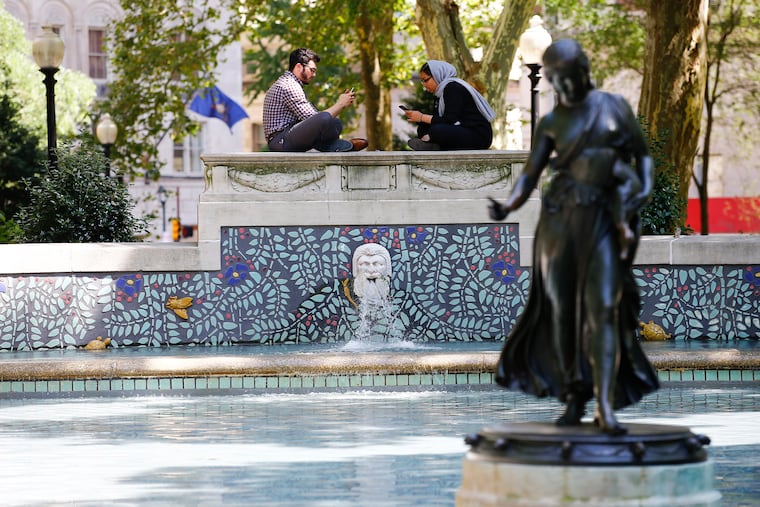How Rittenhouse Square got its fountain, and how it’s used today
The fountain is a stone figurine of Neptune’s head that was meant to appeal to children.

In the middle of Rittenhouse Square rests its centerpiece: a reflecting pool whose fountain spews water into the rectangle.
In the summer, the pool acts as makeshift benches for square-goers to sit and eat. In cooler temperatures, it’s a mini playground. And in all weather, it’s an object of delight and curiosity for Philadelphians.
The fountain is a stone figurine of Neptune’s head that spouts water out of its mouth.
The square and its focal point prompted a question from an Inquirer reader through our Curious Philly question-and-answer portal: Why, in May, was the fountain off, and the reflecting pool water-less? The reader noted that this created a bit of an eyesore for the square, calling the dry fountain "a black eye.”
Typically, fountains are turned off during the winter, and back on in spring or early summer, according to the Friends of Rittenhouse.
According to a spokesperson for the Philadelphia Parks and Recreation Department, the Rittenhouse Square fountain is typically turned on around Easter. However, this year, it was postponed to mid-May due to low temperatures. (Philadelphia was experiencing temperatures in the 40s toward the end of April.)
Regardless of the fountain’s status, the park is a popular spot for parents and caregivers to bring children during the day.
Maura Difilippo, a nanny in the area, said the site is actually more fun when the fountain is off.
“The park isn’t that great for kids,” Difilippo said at the park recently with a young boy she cares for, Graham. “He can’t ride his bike or anything, so it’s fun for the kids to play in the fountain when it’s empty and draw in it with chalk.”
A long history
Nancy Heinzen, author of The Perfect Square: A History of Rittenhouse Square and a member of the Friends of Rittenhouse Square, said site has changed quite a bit over the centuries.
Planned by William Penn and originally built in 1683, the square was originally just open field.
“It was common ground,” Heinzen said. “People just grazed their cattle.”
The neighborhood started out as a modest area, and evolved into today’s upscale blocks.
“The first people were very ordinary folks. It wasn’t until the Civil War when people in Philadelphia made huge fortunes,” Heinzen said. “So then they started to build homes around the square, and that’s when it became known as this enclave of beautiful mansions.”
A renovation to make ‘a thing of beauty’
The reflecting pool, added in 1913, was built by French architect Paul Cret. According to Inquirer archives, the renovation was meant to transform “one of the commonplace city parks into a thing of beauty.”
A December 1913 article described the plan for the fountain and reflecting pool: “In the centre of the square is to be a beautiful fountain, with a pool coping of limestone. From this children may float small boats, as is done in the pools of the Paris Monceau of Paris.”
“The idea of the reflecting pool was to reflect the area around it — it mirrors the trees and everything,” Heinzen said.
According to Heinzen, the small figurines of animals — salamanders, turtles, dolphins, and more — and Neptune’s head were meant to appeal to children.
“People always want to know why the dolphins don’t spout water,” she said. “The reason is, debris from the trees above block the filter inside the statue.”
A place to play
Although the fountain’s water presents problems for kids hoping to draw and play in it, the park still has fans.
“We get our dose of nature, and we see lots of friendly faces here,” said Rhianon Schulz, a nanny at the park on a recent afternoon with 5-year-old Maeve. “She doesn’t have a yard, so this is her backyard.”
» READ MORE: The kids liked Rittenhouse Square’s new kid on the block — but the live stuff was even better